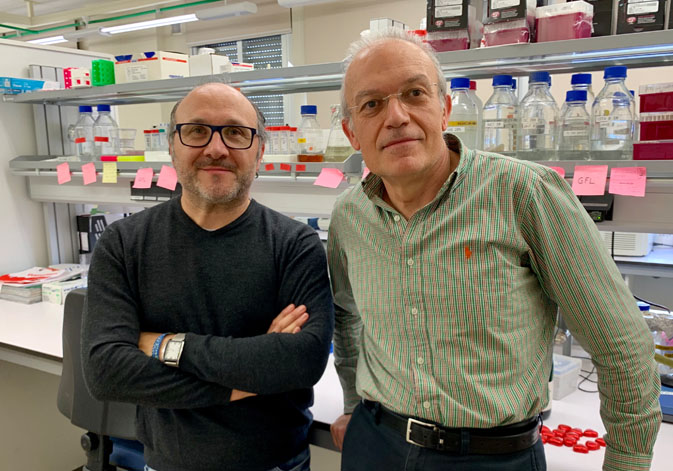Researchers of the Universitat de València describe a new function of a protein implied in the genomic transcription
- Scientific Culture and Innovation Unit
- March 22nd, 2019

José García Martínez and José E. Pérez Ortín, both members of the group of Yeasts Functional Genomics of the Universitat de València, participated in the international research which proves that the protein Xrn1 coordinates the three main stages of the gen expression (transcription, translation and degradation) in contrast to what was believed up to now. According to the research published yesterday in the journa Nature Communications, it is predictable that this phenomenon will be common to every eukaryote organism, including the human beings.
“Genes are written instructions in DNA language. To use these instructions, cells need different protein machinery that first transcribes DNA to messenger RNA (mRNA), which uses a very similar language, and then translates it into proteins, which are the real executors of genetic information”, according to Pérez Ortín . Proteins use a very different language, hence the need for translation.
Until now it was thought that each of the stages of the information flow, from DNA to protein, were independent of the previous and subsequent ones. According to the expert, this idea is changing and now it is known that there are multiple interconnections between the stages and that they are driven by polyvalent proteins that act in different processes and moments of the mRNA.
This work, prepared by four research groups led by Juana Díez, of the Pompeu Fabra University, is a continuation of a study carried out by the University of Valencia together with other international groups in which it was proved that Xrn1 served both for transcription and for degradation of most of the yeast mRNA. Although the work has been carried out in yeast as a eukaryotic cell model, it is predicted that this phenomenon will be common in all eukaryotic organisms, including humans, since Xrn1 exists in all. This process is crucial for maintaining the adequate levels of proteins necessary for a healthy cellular state.
Methodologies
The methodology used by the professors of the Department of Genetics and Biochemistry and Molecular Biology, and the Interdisciplinary Research Structure (ERI) Biotecmed of the University of Valencia, has consisted in the application of original genomic techniques developed in their laboratory to measure the synthesis and degradation of all mRNA.
The results show a coordinated control of the three main stages of gene expression by Xrn1 to maintain the balance of the cell membrane proteins. A key area for future research will be to clarify how the transition between the functions of Xrn1 is regulated and responds to the environment.
This study has also involved the University of Bern (Switzerland), the Technion-Israel Institute of Technology (Israel) and the Max Planck Institute of Molecular Biomedicine (Germany). It has been financed by the Ministry of Economy (Spain) and by the PROMETEO program of the Valencian Givernment.
Article: Moreno-Blasco, B.; de Campos-Mata, L.; Bóttcher, R.; García-Martínez, J.; Jungfleisch, J.; Nedialkova, D. D.; Chattopadhyay, S.; Gas, M. E.; Oliva, B.; Pérez-Ortín. J. E.; Leidel, S. A.; Choder, M. & Díez, J.: «The exonuclease Xrn1 activates transcription and translation of mRNAs encoding membrane proteins». Nature Communications (2019) 10:1298 https://doi.org/10.1038/s41467-019-09199-6
File in: Recerca, innovació i transferència , Difusió i comunicació científica , Internacionalització recerca , Facultat de Ciències Biològiques , Grups de recerca , Investigació a la UV , ERIs
















